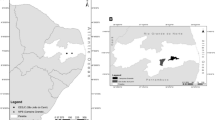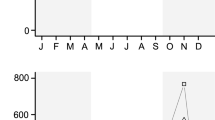Abstract
The turnover patterns in species assemblages along gradients of abiotic or biotic conditions are indicative of the assemblages’ sensitivity to changes in these conditions. Studies of such gradients allow an evaluation of the degree of habitat specialization in different taxa, which will strongly affect their ability to react to changes in climatic conditions. Our study was carried at one of the largest mature temperate forests in northeastern China, Changbai Mountain. We establish how strongly shifts in the assemblages of two mega-diverse insect families, ground beetles and geometrid moths, are associated with changes in the vegetation that are indicative of the degree of habitat specialization, in comparison to altitudinal change that is linked to changes in both temperature and precipitation. Overall, altitudinal change exerted a substantially stronger influence on insect species turnover patterns than vegetation changes, with elevation being particularly strongly linked to turnover in carabid and dominant geometrid species. Significant links were recorded between changes in the vegetation and turnover in both insect taxa, but Partial Mantel Tests reveal that the observed links with the vegetation are partly indirect. The results indicate that many species in both taxa are habitat generalists able to thrive in a wide range of plant species assemblages and vegetation structures. This will facilitate climate change-induced shifts in their distribution ranges. Conservation efforts should therefore be strongly focused on the smaller groups of habitat- and host-plant insect specialists, as well as on assemblages associated with mountain top habitats that will be unable to shift their ranges further upward.


Similar content being viewed by others
References
Andrew NR, Hill SJ, Binns M, Bahar MH, Ridley EV, Jung M-P, Fyfe C, Yates M, Khusro M (2013) Assessing insect responses to climate change: what are we testing for? Where should we be heading? PeerJ 1:e11
Axmacher JC, Tünte H, Schrumpf M, Müller-Hohenstein K, Lyaruu HVM, Fiedler K (2004) Diverging diversity patterns of vascular plants and geometrid moths during forest regeneration on Mt Kilimanjaro, Tanzania. J Biogeogr 31:895–904
Axmacher JC, Brehm G, Hemp A, Tünte H, Lyaruu HVM, Müller-Hohenstein K, Fiedler K (2009) Determinants of diversity in afrotropical herbivorous insects (Lepidoptera: Geometridae): plant diversity, vegetation structure or abiotic factors? J Biogeogr 36:337–349
Axmacher JC, Liu Y, Wang C, Li L, Yu Z (2011) Spatial α-diversity patterns of diverse insect taxa in Northern China: lessons for biodiversity conservation. Biol Conserv 144:2362–2368
Bai F, Sang W, Axmacher JC (2011) Forest vegetation responses to climate and environmental change: a case study from Changbai Mountain, NE China. For Ecol Manag 262:2052–2060
Bale JS, Masters GJ, Hodkinson ID, Awmack C, Bezemer TM, Brown VK, Butterfield J, Buse A, Coulson JC, Farrar J, Good JEG, Harrington R, Hartley S, Jones TH, Lindroth RL, Press MC, Symrnioudis I, Watt AD, Whittaker JB (2002) Herbivory in global climate change research: direct effects of rising temperature on insect herbivores. Glob Change Biol 8:1–16
Beck J, Vun Khen C (2007) Beta-diversity of geometrid moths from northern Borneo: effects of habitat, time and space. J Anim Ecol 76:230–237
Beck J, Schwanghart W, Khen C, Holloway J (2011) Predicting geometrid moth diversity in the Heart of Borneo. Insect Conserv Divers 4:173–183
Brehm G, Homeier J, Fiedler K (2003) Beta diversity of geometrid moths (Lepidoptera: Geometridae) in an Andean montane rainforest. Divers Distrib 9:351–366
Butchart SHM, Walpole M, Collen B, Van Strien A, Scharlemann JPW, Almond REA, Baillie JEM, Bomhard B, Brown C, Bruno J (2010) Global biodiversity: indicators of recent declines. Science 328:1164–1168
Carabidae of the World (2014) Carabidae subfamilies. http://carabidae.org. Accessed 1 Jan 2015
Carneiro E, Mielke OHH, Casagrande MM, Fiedler K (2014) Community structure of skipper butterflies (Lepidoptera, Hesperiidae) along elevational gradients in Brazilian Atlantic forest reflects vegetation type rather than altitude. PLoS ONE 9:e108207
Chen LZ, Bao XC, Li CG (1964) Major forests in various vertical zones on northern slope of Changbai Mountains of Jilin Province. Acta Phytoecol Geobot Sin 2:207–225
Chen I-C, Shiu H-J, Benedick S, Holloway JD, Chey VK, Barlow HS, Hill JK, Thomas CD (2009) Elevation increases in moth assemblages over 42 years on a tropical mountain. PNAS 106:1479–1483
Condit R, Pitman N, Leigh EG Jr, Chave J, Terborgh J, Foster RB, Núnez P, Aguilar S, Valencia R, Villa G (2002) Beta-diversity in tropical forest trees. Science 295:666–669
Den Boer PJ (1970) On the significance of dispersal power for populations of carabid-beetles (Coleoptera, Carabidae). Oecologia 4:1–28
Gallagher ED (1998) Compah96. http://www.es.umb.edu/faculty/edg/files/pub/COMPAH.EXE. Accessed 01 Sept 2013
Gillingham PK, Palmer SCF, Huntley B, Kunin WE, Chipperfield JD, Thomas CD (2012) The relative importance of climate and habitat in determining the distributions of species at different spatial scales: a case study with ground beetles in Great Britain. Ecography 35:831–838
Hawkins BA, Porter EE (2003) Does herbivore diversity depend on plant diversity? The case of California butterflies. Am Nat 161:40–49
Heimonen K, Lwanga JS, Mutanen M, Nyman T, Roininen H (2013) Spatial and temporal variation in community composition of herbivorous insects on Neoboutonia macrocalyx in a primary tropical rain forest. J Trop Ecol 29:229–241
Hódar JA, Zamora R (2004) Herbivory and climatic warming: a Mediterranean outbreaking caterpillar attacks a relict, boreal pine species. Biodivers Conserv 13:493–500
Holloway JD (ed) (1985) Moths as indicator organisms for categorizing rain-forest and monitoring changes and regeneration processes. Philos Lit Soc, Leeds
Hubbell SP (2001) The unified neutral theory of biodiversity and biogeography. Princeton University Press, Princeton
Koivula M, Punttila P, Haila Y, Niemelä J (1999) Leaf litter and the small-scale distribution of carabid beetles (Coleoptera, Carabidae) in the boreal forest. Ecography 22:424–435
Kotze DJ, Brandmayr P, Casale A, Dauffy-Richard E, Dekoninck W, Koivula MJ, Lövei GL, Mossakowski D, Noordijk J, Paarmann W (2011) Forty years of carabid beetle research in Europe—from taxonomy, biology, ecology and population studies to bioindication, habitat assessment and conservation. ZooKeys 100:55–148
Legendre P, Gallagher E (2001) Ecologically meaningful transformations for ordination of species data. Oecologia 129:271–280
Lindner M, Maroschek M, Netherer S, Kremer A, Barbati A, Garcia-Gonzalo J, Seidl R, Delzon S, Corona P, Kolström M, Lexer MJ, Marchetti M (2010) Climate change impacts, adaptive capacity, and vulnerability of European forest ecosystems. For Ecol Manag 259:698–709
Liu Y, Axmacher JC, Wang C, Li L, Yu Z (2010) Ground beetles (Coleoptera: Carabidae) in the intensively cultivated agricultural landscape of Northern China—implications for biodiversity conservation. Insect Conserv Divers 3:34–43
Lövei GL, Sunderland KD (1996) Ecology and behavior of ground beetles (Coleoptera: Carabidae). Annu Rev Entomol 41:231–256
Macgregor CJ, Pocock MJO, Fox R, Evans DM (2015) Pollination by nocturnal Lepidoptera, and the effects of light pollution: a review. Ecol Entomol 40:187–198
Magurran AE (2004) Measuring biological diversity. Blackwell, Oxford
McKnight MW, White PS, McDonald RI, Lamoreux JF, Sechrest W, Ridgely RS, Stuart SN (2007) Putting beta-diversity on the map: broad-scale congruence and coincidence in the extremes. PLoS Biol 5:e272
McLeod R, Balaban J, Balaban J, Moisset B, Entz C (2009). Family Geometridae—geometrid moths. BugGuide. http://bugguide.net/node/view/188. Accessed 15 Jan 2015
Niemelä J, Spence JR, Spence DH (1992) Habitat associations and seasonal activity of ground-beetles (Coleoptera, Carabidae) in central Alberta. Can Entomol 124:521–540
Oksanen J, Blanchet FG, Kindt R, Legendre P, Minchin P, O’Hara R, Simpson G, Solymos P, Stevens M, Wagner H (2012) vegan: Community Ecology Package. R package version 2.0-3
Pateman RM, Hill JK, Roy DB, Fox R, Thomas CD (2012) Temperature-dependent alterations in host use drive rapid range expansion in a butterfly. Science 336:1028–1030
Rainio J, Niemelä J (2003) Ground beetles (Coleoptera: Carabidae) as bioindicators. Biodivers Conserv 12:487–506
Robinson GS, Ackery PR, Kitching IJ, Beccaloni GW, Hernández LM (2010) HOSTS—a database of the World’s Lepidopteran Hostplants. http://www.nhm.ac.uk/hosts. Accessed 01 July 2015
Rodríguez-Castañeda G, Dyer LA, Brehm G, Connahs H, Forkner RE, Walla TR (2010) Tropical forests are not flat: how mountains affect herbivore diversity. Ecol Lett 13:1348–1357
Rzanny M, Kuu A, Voigt W (2012) Bottom-up and top-down forces structuring consumer communities in an experimental grassland. Oikos 122:967
Samways MJ (2005) Insect diversity conservation. Cambridge University Press, Cambridge
Sanders NJ, Rahbek C (2012) The patterns and causes of elevational diversity gradients. Ecography 35:1
Sang W, Bai F (2009) Vascular diversity patterns of forest ecosystem before and after a 43-year interval under changing climate conditions in the Changbaishan Nature Reserve, northeastern China. Plant Ecol 201:115–130
Schaffers AP, Raemakers IP, Sýkora KV, Ter Braak CJ (2008) Arthropod assemblages are best predicted by plant species composition. Ecology 89:782–794
Schuldt A, Baruffol M, Böhnke M, Bruelheide H, Härdtle W, Lang AC, Nadrowski K, Von Oheimb G, Voigt W, Zhou H (2010) Tree diversity promotes insect herbivory in subtropical forests of south-east China. J Ecol 98:917–926
Schuldt A, Bruelheide H, Durka W, Eichenberg D, Fischer M, Kröber W, Härdtle W, Ma K, Michalski SG, Palm WU (2012) Plant traits affecting herbivory on tree recruits in highly diverse subtropical forests. Ecol Lett 15:732–739
Sobek S, GoßNer MM, Scherber C, Steffan-Dewenter I, Tscharntke T (2009) Tree diversity drives abundance and spatiotemporal β-diversity of true bugs (Heteroptera). Ecol Entomol 34:772–782
Spence JR, Niemelä JK (1994) Sampling carabid assemblages with pitfall traps: the madness and the method. Can Entomol 126:881–894
Stevens GC (1992) The elevational gradient in altitudinal range: an extension of Rapoport’s latitudinal rule to altitude. Am Nat 140:893–911
R Core Team (2014) R: a language and environment for statistical computing. R Foundation for Statistical Computing, Vienna. http://www.R-project.org/
Townsend CR, Hughes RN (1981) Maximizing net energy returns from foraging. In: Townsend CR, Calow P (eds) Physiological ecology. An evolutionary approach to resource use. Blackwell, Oxford, pp 86–108
Trueblood DD, Gallagher ED, Gould DM (1994) Three stages of seasonal succession on the Savin Hill Cove mudflat, Boston Harbor. Limnol Oceanogr 39:1440–1454
Tuomisto H, Ruokolainen K (2006) Analyzing or explaining beta diversity? Understanding the targets of different methods of analysis. Ecology 87:2697–2708
Voigt W, Perner J, Davis AJ, Eggers T, Schumacher J, Bährmann R, Fabian B, Heinrich W, Köhler G, Lichter D (2003) Trophic levels are differentially sensitive to climate. Ecology 84:2444–2453
Wilson R, Maclean ID (2011) Recent evidence for the climate change threat to Lepidoptera and other insects. J Insect Conserv 15:259–268
Zou Y, Sang W, Bai F, Axmacher JC (2013) Relationships between plant diversity and the abundance and α-diversity of predatory ground beetles (Coleoptera: Carabidae) in a mature Asian temperate forest ecosystem. PLoS ONE 8:e82792
Zou Y, Sang W, Zhou H, Huang L, Axmacher JC (2014) Altitudinal diversity patterns of ground beetles (Coleoptera: Carabidae) in the forests of Changbai Mountain, Northeast China. Insect Conserv Divers 7:161–171
Acknowledgments
This research was funded by the National Natural Science Foundation of China (31270478), the Chinese Academy of Sciences’ Fellowship for International Scientists (Fellowship Number 2011T2S18) and the ‘111 Program’ of the Bureau of China Foreign Experts and the Ministry of Education (2008-B08044). We thank Professor Liang Hongbin, Dr. Shi Hongliang and Liu Ye for help with the carabid identification and Professor Xue Dayong as well as Dr. Han Hongxiang for their help with geometrid identification. We also thank Dr. Axel Hausmann for helping with the geometrid DNA barcoding and moth identification. We also thank the Changbaishan Forest Ecosystem Research Station and Changbaishan Natural Museum for their kind on-site support of our research.
Author information
Authors and Affiliations
Corresponding authors
Electronic supplementary material
Below is the link to the electronic supplementary material.
Rights and permissions
About this article
Cite this article
Zou, Y., Sang, W. & Axmacher, J.C. Resilience of insect assemblages to climate change in mature temperate mountain forests of NE China. J Insect Conserv 19, 1163–1172 (2015). https://doi.org/10.1007/s10841-015-9831-0
Received:
Accepted:
Published:
Issue Date:
DOI: https://doi.org/10.1007/s10841-015-9831-0




